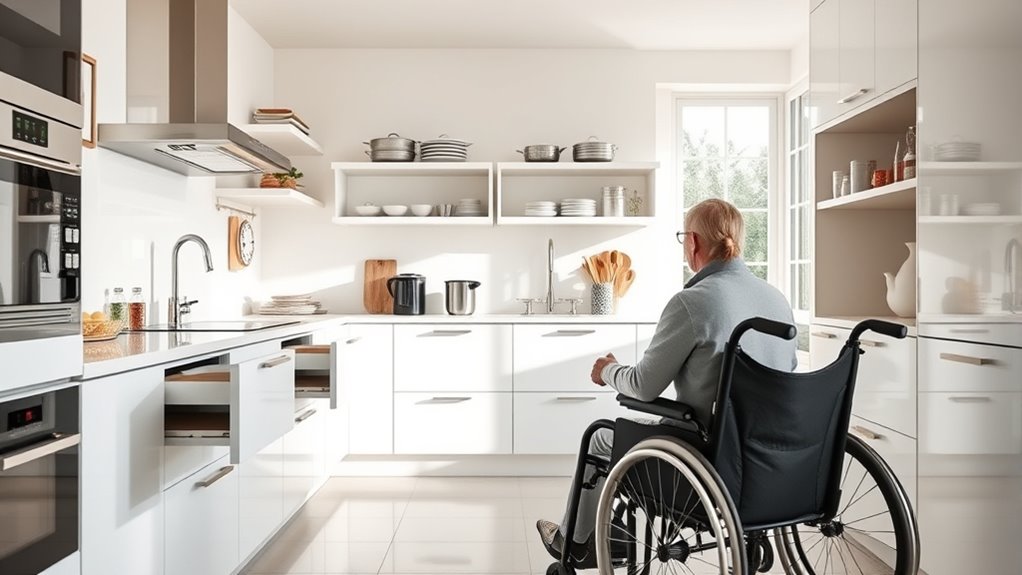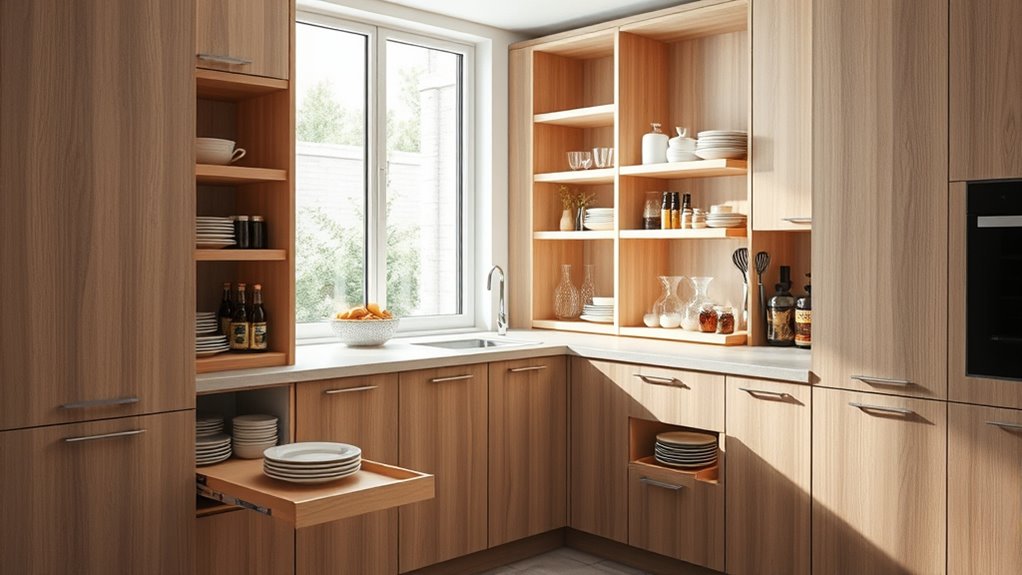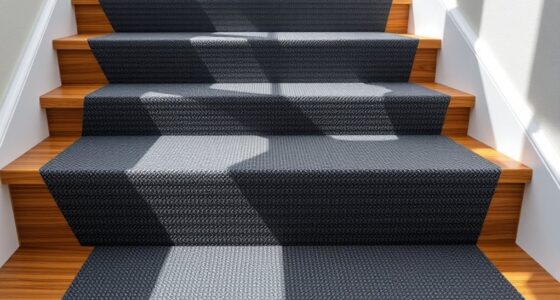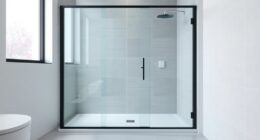To design an accessible kitchen with pull-out shelves, focus on creating an ergonomic layout that keeps frequently used items within easy reach and minimizes unnecessary movement. Use high-quality, soft-close hardware that glides smoothly and supports safety and stability. Place shelves at adjustable heights and incorporate safety features like lock mechanisms and good lighting. Keep the space clutter-free around the work triangle to ensure safe and effortless access. Continuing will help you learn how to make your kitchen truly user-friendly and safe.
Key Takeaways
- Position frequently used items at waist level or within easy reach to minimize strain and improve accessibility.
- Incorporate soft-close and locking hardware on pull-out shelves for safety and smooth operation.
- Design shelves at adjustable heights to accommodate individual needs and enhance user comfort.
- Ensure shelves are sturdy, support heavy items, and lock securely to prevent accidental tipping or sliding.
- Integrate pull-out shelves into the kitchen work triangle for efficient workflow and space optimization.

Creating an accessible kitchen guarantees everyone can cook, clean, and enjoy their space with ease. When you design with pull-out shelves in mind, you’re making your kitchen more functional and user-friendly, especially for those with limited mobility or strength. To start, focus on an ergonomic layout that minimizes unnecessary movement and strain. Position frequently used items—pots, pans, utensils—at waist level or within easy reach, so you don’t have to bend, stretch, or twist to access them. Pull-out shelves are perfect for this, as they allow you to see and reach items without crouching or climbing on tiptoes, reducing physical effort and the risk of injury. Incorporating body awareness techniques can help you optimize your space for comfort and safety. Safety precautions are vital when incorporating pull-out shelves into your kitchen design. Ensure that all shelves glide smoothly and lock securely in place, so they don’t unexpectedly slide out or tip over. Use sturdy, high-quality hardware to support the weight of stored items—heavy pots, canned goods, or small appliances—and prevent accidents. Keep sharp objects, cleaning supplies, and other hazardous items stored safely away from the reach of children or those with limited dexterity. Consider adding soft-close mechanisms to prevent pinched fingers, and make sure there’s adequate clearance around shelves to avoid bumping into neighboring cabinets or appliances. When planning your layout, think about the overall flow of your kitchen. An ergonomic design isn’t just about individual shelves—it’s about how everything works together. Place the sink, stove, and refrigerator in a work triangle so you can move efficiently between them. Pull-out shelves work best when positioned near these core areas, making it simple to grab ingredients or utensils without unnecessary steps. Keep countertops clear and clutter-free, providing enough space for meal prep and cleaning. Proper lighting is essential, especially around pull-out shelves, to help you see everything clearly and avoid accidents. Accessibility also means considering ease of operation. Pick pull-out shelves with ergonomic handles that are easy to grip, even for those with limited hand strength. Test the mechanism before installation to ensure smooth, effortless operation, and place shelves at heights that suit your needs. By combining thoughtful layout, safety precautions, and easy-to-use hardware, you create a kitchen that’s welcoming, safe, and adaptable. This approach not only enhances safety but also boosts your confidence and independence in the kitchen, turning a functional space into one that truly works for everyone.
Frequently Asked Questions
What Materials Are Best for Pull-Out Shelves in Accessible Kitchens?
You should choose materials like solid wood, plywood, or metal for pull-out shelves because they offer excellent durability, ensuring your shelves last over time. These materials also come in various aesthetic options, so you can match your kitchen’s style. Metal shelves are sturdy and modern, while wood provides warmth and elegance. Opt for these durable, attractive materials to create functional, beautiful, and long-lasting accessible kitchen storage.
How Can I Customize Pull-Out Shelves for Specific Items?
Your pull-out shelves can become your kitchen’s secret weapon for organization! Use custom shelf dividers to separate items neatly, and adjust shelf heights to fit everything perfectly. By tailoring each shelf to specific items, you’ll make grabbing what you need effortless and efficient. This customization turns your kitchen into a well-orchestrated space, making daily tasks smoother and more enjoyable—like having a personal assistant right at your fingertips.
Are There Safety Features to Consider for Pull-Out Shelves?
To guarantee safety, look for pull‑out shelves with child safety features like locking mechanisms or soft-close slides to prevent accidents. Always check the weight capacity and avoid overloading shelves, which could cause tipping or breakage. Consider installing shelves at accessible heights, especially for children or individuals with mobility challenges, to reduce the risk of injury. Regularly inspect the hardware to maintain safety and functionality.
What Is the Average Cost of Installing Pull-Out Shelves?
Oh, the thrill of budgeting! On average, installing pull-out shelves costs between $150 and $600 per unit, depending on size and material. You’ll want to do a cost comparison to see what fits your budget, but don’t forget, the convenience and accessibility are priceless. Planning ahead helps you avoid surprise expenses and guarantees your kitchen upgrade stays within your financial comfort zone. Happy budget planning!
How Do I Maintain and Clean Pull-Out Shelves Effectively?
To maintain your pull-out shelves effectively, follow regular cleaning routines by wiping them with a damp cloth and mild soap. Avoid harsh chemicals to protect material durability. Check for debris or dirt buildup and clean tracks to ensure smooth operation. Keep the shelves dry to prevent warping or rust. Regular maintenance preserves their functionality and appearance, making your accessible kitchen safer and more efficient for everyday use.
Conclusion
Think of your kitchen as a well-tended garden. Just as every plant needs easy access to sunlight and water, your space should be designed so you can reach everything effortlessly. Pull-out shelves act like pathways that guide you smoothly through your daily tasks, turning your kitchen into a thriving, accessible oasis. With thoughtful design, you’ll enjoy a space where every corner is within your reach, making your cooking experience both joyful and stress-free.









